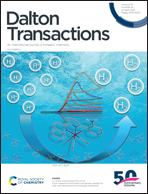Hydroxido supported and differently networked octanuclear Ni6Ln2 [Ln = GdIII and DyIII] complexes: structural variation, magnetic properties and theoretical insights†
Abstract
The design and synthesis of a Schiff base H2L, (2-{[(2-hydroxy-3-methoxybenzyl)imino]methyl}phenol), bearing an ONOO donor set has been explored for its reactivity pattern with LnCl3·6H2O (Ln = GdIII and DyIII) and Ni(CH3CO2)2·4H2O in the presence of NEt3 for molecular aggregation. Coordination driven spontaneous self-assembly reactions provide [Gd2Ni6L4(μ3-OH)6(μ-OH)2(CH3CO2)2(μ-H2O)2(H2O)3(MeOH)]·8H2O (1) having a ‘butterfly-shaped’ core and [Dy2Ni6L4(μ3-OH)4(μ-Cl)2Cl4(H2O)2(MeOH)2]·2MeOH·4H2O (2) with a ‘candy-shaped’ core. Fusion of six partial cubane units led to a mineral-like core in 1, developed around the central Ni2(OH)2 moiety, whereas in the case of 2, four such partial cubanes collapsed on Dy2(OH)2. Direct-current (dc) magnetic susceptibility measurements revealed that predominant ferromagnetic interactions lead to a high-spin S = 13 ground state for 1. Complex 2 exhibits slow relaxation of magnetization under an applied small dc field with an energy barrier to reorientation of the magnetization, Ueff = 19.3 K. The static and dynamic magnetic data are analysed and corroborated by density functional theory (DFT) and detailed CASSCF based calculations.
![Graphical abstract: Hydroxido supported and differently networked octanuclear Ni6Ln2 [Ln = GdIII and DyIII] complexes: structural variation, magnetic properties and theoretical insights](/en/Image/Get?imageInfo.ImageType=GA&imageInfo.ImageIdentifier.ManuscriptID=D0DT04168H&imageInfo.ImageIdentifier.Year=2021)


 Please wait while we load your content...
Please wait while we load your content...